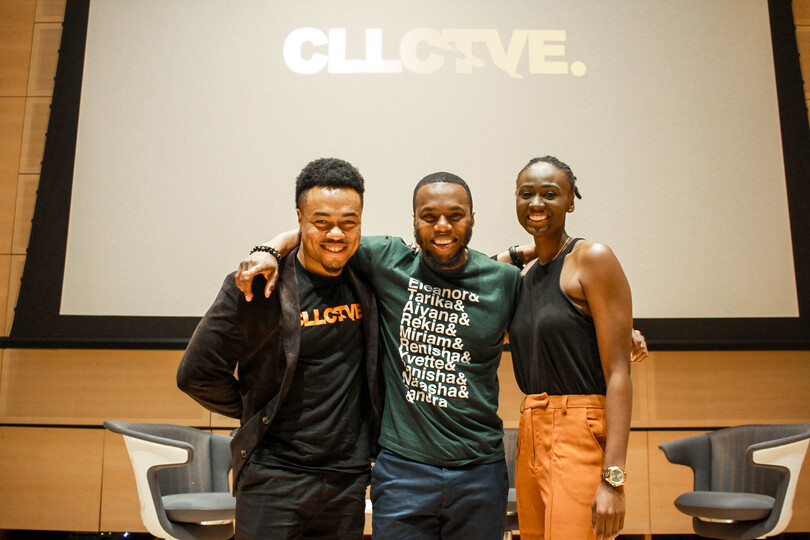Young black creatives are exploited by a broken system — 2 SU seniors want to change that

Student-run creative agency CLLCTVE hosted its "Art of Finesse" conference on Sunday, Oct. 28. Founders of the startup, Ryan Williams (left) and Kelsey Davis (right), hosted panels and workshops featuring guests Jonathan Jackson (middle), Tiffany Bender and Evin Robinson. Courtesy of CLLCTVE
A week ago, Syracuse University seniors Kelsey Davis and Ryan Williams hosted a conference through their startup CLLCTVE, a student-run agency that works with universities, brands and artists to provide opportunities for college creatives. The event included a series of workshops, lectures and demonstrations. Moderators spoke about leveraging social influence into power and financial gain, spreading a message that speaks to why CLLCTVE’s mission is so important.
Creativity, particularly through art, is at the core of both youth and black American culture. Sold as a product, black creatives have almost always been highly valued, emulated and admired. Despite the value of their work, these creatives, often lacking proper access to resources, have long been exploited.
The history of this exploitation can be famously seen in the story of rock n’ roll. Today’s rock stars are almost exclusively white, despite early pioneers of the genre being young African wAmericans. In the early days of the genre, black artists like Chuck Berry and Little Richard sold tons of records, created huge followings and amassed huge crowds. In these crowds were people like Elvis Presley, Bruce Springsteen and Mick Jagger.
Despite their influence on the sound, these young, black pioneers were not given equitable contracts or ownership of their work. As the genre grew, successful black-American rock stars became an anomaly. Without mainstream media attention, many lost gigs to the white men they inspired (see Jimi Hendrix).
More recently, in 2014, artist 2 Milly released a video, featuring his now-famous “Milly Rock,” that received more than 17 million views on YouTube. What originated years ago as a fun dance between friends blew up into a nationwide phenomenon. Two years later, his “Milly Rock” has been mentioned on hit records, performed by Beyoncé at the Super Bowl and featured on popular games like “Fortnite” (“Swipe It” move), and “NBA 2K18.”
The creator of the dance, 2 Milly, has not received adequate compensation for his dance move. He’s threatened to sue Epic Games (owner of “Fortnite”) saying, “I just don’t think they should’ve stolen … we go so hard for our talents, whatever we create.” While 2 Milly would sue for the right to his intellectual property, “Fortnite” will continue its run as one of the highest-grossing video games of all time.
Too often, black creatives are driven into exploitative contracts without access to trusted business services. Desperate for an opportunity, young black creatives often substitute monetary compensation with promises of fame or celebrity.
Accepting this form of “payment,” many young, black creatives have missed out on opportunity for effective power, instead chasing what is modernly known as “clout.” Davis said, “Most people who are operating in a broken system know that the system is broken, but there’s an incentivized reason as to why they’re giving into that system.” CLLCTVE wishes to change this.
Serving as a liaison between creators and brands, this student-run platform empowers students to develop their craft, understand their respective industries, recognize opportunities and precisely quantify the value of their work.
As young, black creatives themselves, Davis and Williams hope to grow alongside the company while making a lasting change in the way creatives approach, and are received within their creative industries.
Jalen Nash is a junior political science major. His music column appears weekly in Pulp. You can email him at janash@syr.edu or follow him on Twitter @ja_nash3.





